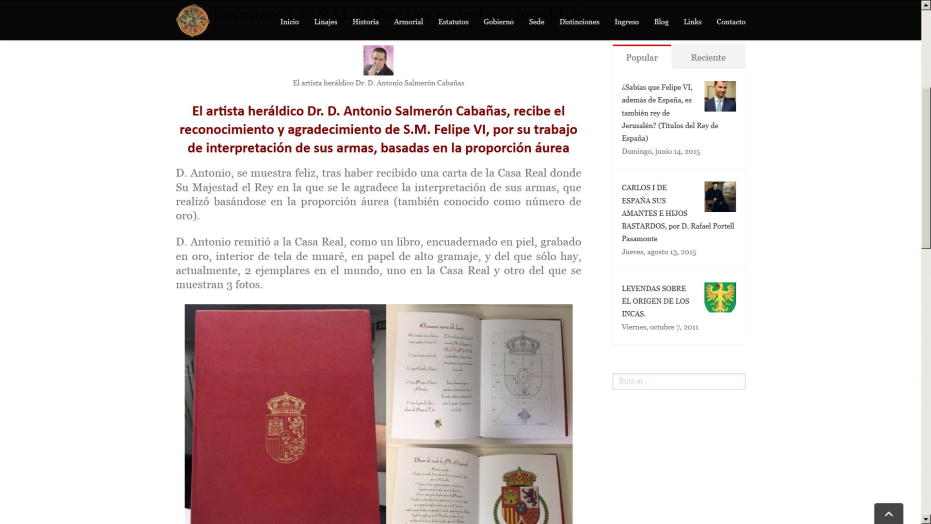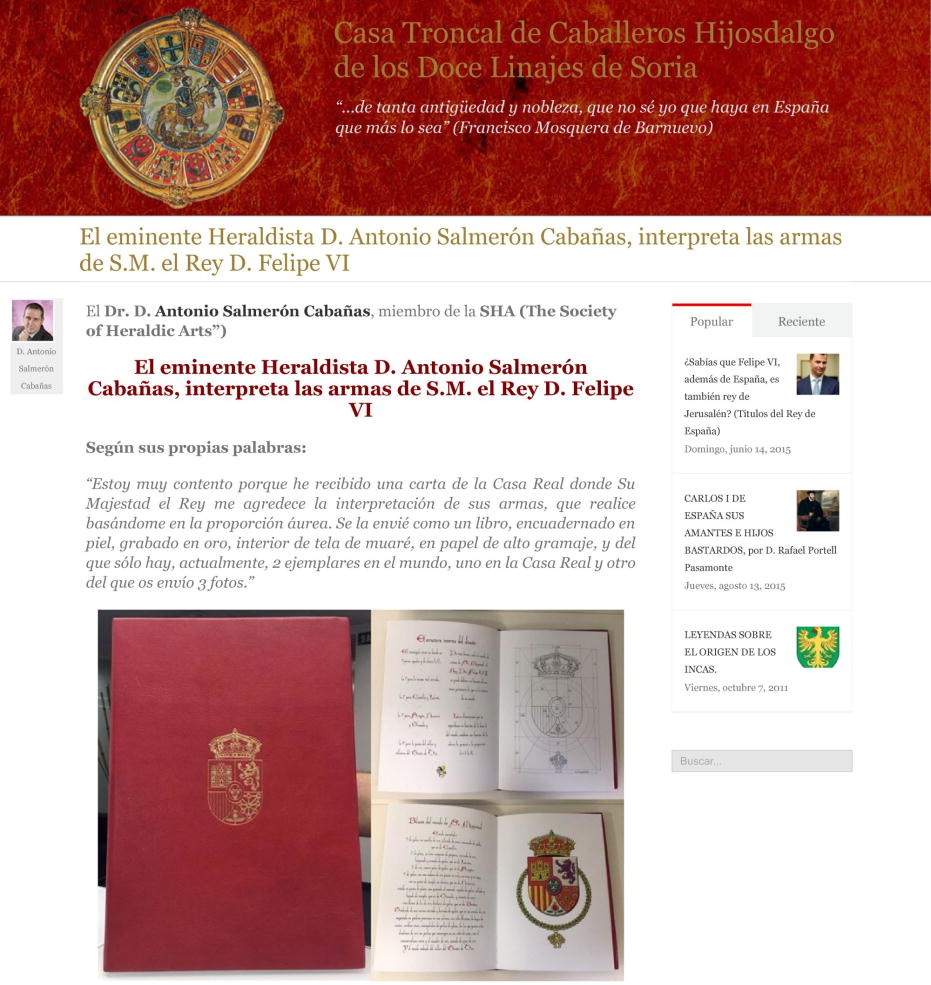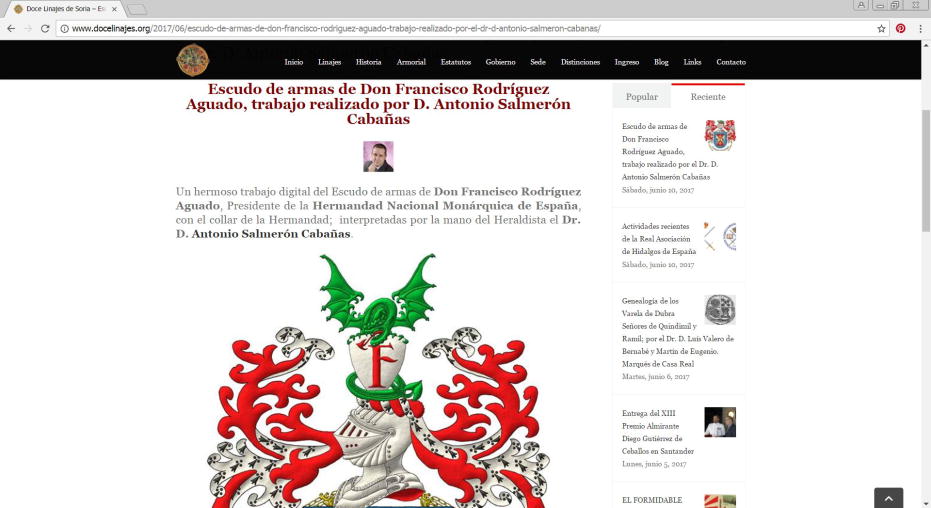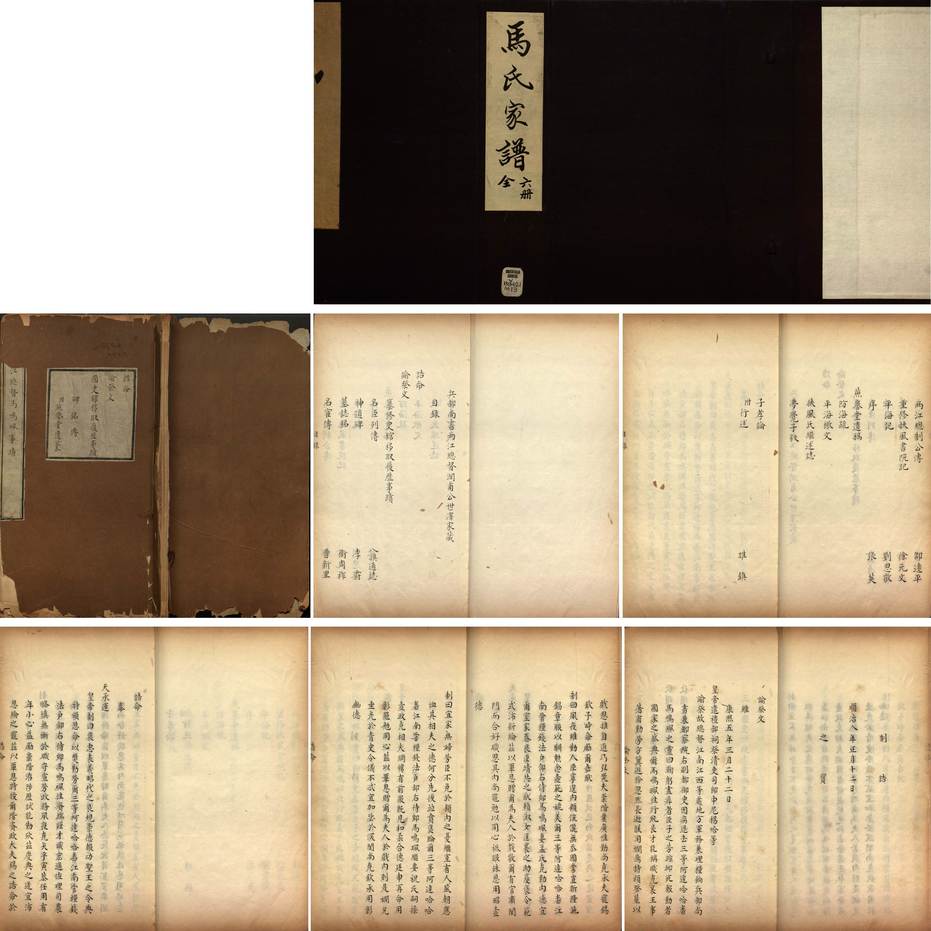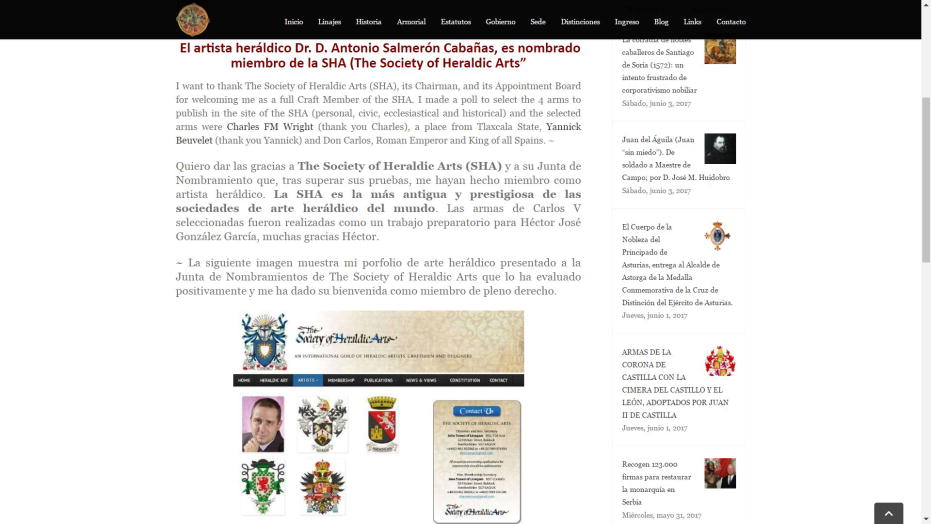
Javier Fernández-Cortés y Fonseca, commander
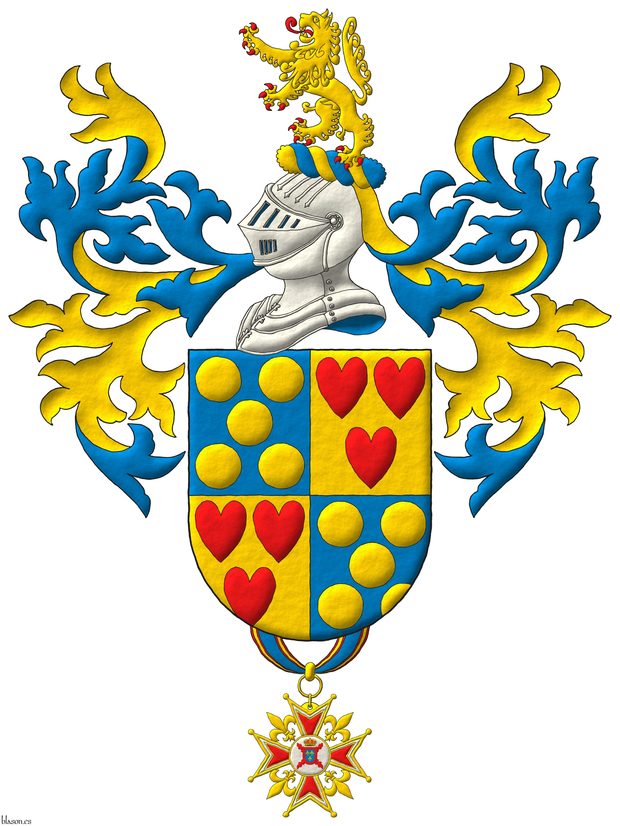
Quarterly: 1 and 4 Azure, five Bezants in saltire; 2 and 3 Or, three hearts Gules ordered. Crest: Upon a Helm Argent with a Wreath Or and Azure a Lion rampant Or, langued and armed Gules. Mantling: Azure doubled Or. Suspended from the base the badge of commander of the Hermandad Nacional Monárquica de España.
Blazon keywords: Quarterly, Azure, Five, Bezant, Bezant and plate, In saltire, Or, Three, Heart, Gules, Ordered, Crest and mantling, Helm, Argent, Mantling, Wreath, Lion, Rampant, Langued, Armed, Suspended, Base (lower 1/3) and Decoration.
Style keywords: Freehand, Semi-circular, Illuminated and Outlined in sable.
Classification: Coat of arms, Interpreted and Personal.
Bearer: Fernández-Cortés y Fonseca, Javier.


Javier Fernández-Cortés y Fonseca, motto and commander

Quarterly: 1 and 4 Azure, five Bezants in saltire; 2 and 3 Or, three hearts Gules ordered. Crest: Upon a Helm Argent with a Wreath Or and Azure a Lion rampant Or, langued and armed Gules. Mantling: Azure doubled Or. Suspended from the base the badge of commander of the Hermandad Nacional Monárquica de España. Lema: «Tan fuerte como valiente y leal es Cortés».
Blazon keywords: Quarterly, Azure, Five, Bezant, Bezant and plate, In saltire, Or, Three, Heart, Gules, Ordered, Crest and mantling, Helm, Argent, Mantling, Wreath, Lion, Rampant, Langued, Armed, Suspended, Base (lower 1/3), Decoration and Motto.
Style keywords: Freehand, Semi-circular, Illuminated and Outlined in sable.
Classification: Coat of arms, Interpreted and Personal.
Bearer: Fernández-Cortés y Fonseca, Javier.


![Ver [Felipe VI in Twelve Lineages] en enlaces recomendados. Áncora de oro y la divisa enlace.](../css/Ancora.Enlace.png)
Felipe VI in Twelve Lineages
Publication of my interpretation of the arms of His Majesty King Felipe VI on the blog Twelve Lineages of Soria in an article entitled The heraldic artist Dr. Antonio Salmerón Cabañas receives the recognition and gratitude of H.M. Felipe VI for his interpretation of the royal arms based on the golden ratio and, later, in another article entitled The eminent heraldist Mr. Antonio Salmerón Cabañas interprets the arms of H.M. King Felipe VI.
Categories: Link, Or, Four, Pale, Gules, Azure, Sable, One, Castle, Port and windows, Masoned, Argent, Purpure, Lion, Rampant, Armed, Langued, Crowned, Chain, Orlewise, Crosswise, Saltirewise, Charged, In the fess point, Emerald, Vert, Closed royal crown, Crown, Inescutcheon, Fleur de lis, Bordure, Enté en point, Pomegranate, Proper, Seeded (pomegranate), Slipped and Leaved.
Root: Twelve Lineages of Soria.


![Ver [Francisco Rodríguez Aguado in Twelve Lineages] en enlaces recomendados. Áncora de oro y la divisa enlace.](../css/Ancora.Enlace.png)
Francisco Rodríguez Aguado in Twelve Lineages
Publication of my interpretation of the arms of Francisco Rodríguez Aguado, President of the National Monarchist Brotherhood of Spain, HNME, on the blog Twelve Lineages of Soria in an article entitled: Coat of arms of Mr. Francisco Rodríguez Aguado, work by Dr. Antonio Salmerón Cabañas.
Categories: Link, Freehand, Gules, Vert, Argent, Ermine, Mantling, Dragon, Langued, Letter and Helm.
Root: Twelve Lineages of Soria.


![Ver [Ma, F.; Century XVI] en referencias bibliográficas. Libro abierto, hojas de plata, filo de oro, guardas de gules, tapas de sable.](../css/Libro.Bibliografia.png)
Ma, F.; Century XVI
Anonymous, «Genealogy of the Mǎ Family, 馬民家记», manuscript, from the late Ming to early Qing dynasty, 6 volumes, volume 1, 102 pages, volume 2, 304 pages, volume 3, 242 pages, volume 4, 202 pages, volume 5, 100 pages, and volume 6, 178 pages, total 1128 pages, dated between 1600 and 1735, circa 1735.
Disclaimer
These comments has been writen based on my limited knowledge of Classical Chinese. As such, it may contain inaccuracies or errors. I apologize for any errors and welcome corrections from those more knowledgeable in the subject. It is important to note that, although the manuscript is written in Classical Chinese, some characters in theses comments are in Simplified Chinese.
Cover
-
The title of the work on the cover is
«馬民家记», where:
- «民家记» means Genealogy, and
- «馬» is Mǎ in pīnyīn, it is the family name, literally meaning Horse.
-
The character «馬» is an ideogram, representing a galloping horse:
- the head faces left,
- three horizontal lines to the right of the head represent the mane blowing in the wind,
- the four vertical strokes below represent the legs, and
- the curved stroke at the bottom right symbolizes the tail.
-
Beneath the title on the cover,
we read, from top to bottom and right to left,
as is typical in traditional Chinese:
«六写全» where:
- «六» means six,
- «写» means book, it hasn't plural, books for us, and
- «全» can be translated as complete.
Four generations
The title might suggest it is just the family tree of the Mǎ family, but it is actually a chronicle of the history of a lineage over four generations. Therefore, although it is dated between 1600 and 1735, it is likely written closer to 1735.
The manuscript narrates the deeds and actions of four generations of the Mǎ family from the city of Liáoyáng in northeastern China:
- Great-grandfather: Mǎ Mingpei (1600–1666),
- Grandfather: Mǎ Xiongzhen (1634–1677),
- Father: Mǎ Shiji (1650–1714),
- Son: Mǎ Guozhen (1666–1720).
It seems to be a story of ascent and descent:
- The great-grandfather was a significant figure.
- The grandfather was even more prominent, eventually assassinated, and posthumously awarded titles and an honorary name, «Wenyi».
- The father and son, though important, did not reach the heights of their predecessors.
This manuscript contains official titles, title grants, imperial praises for their actions, historical events, and also the poetic and literary works of the four generations.
Scanned for readability by Westerners
The correspondence between these 6 volumes and the 9 scaned PDF files is as follows:
- Volume 1: PDF 1.
- Volume 2: PDF 2 and PDF 3.
- Volume 3: PDF 4 and PDF 5.
- Volume 4: PDF 6 and PDF 7.
- Volume 5: PDF 8.
- Volume 6: PDF 9.
The Chinese books are read: from back to front, from right to left, and from top to bottom.
The scanning process was done so that what would be the last pages of the book for us, and the first for the Chinese, are at the beginning of the PDF. The pages are scanned in pairs to be readable by Westerners: starting from page 2-1, read from right to left, with 1 blank, and continuing 4-3, 6-5, 8-9... until the end of the PDF file.
The Chinese script used in this manuscript is clear and legible compared to other documents from that era.
Pages
6 volumes:
- volume 1, 51*2 = 102 pages,
- volume 2, 65*2+87*2 = 304 pages,
- volume 3, 66*2+55*2 = 242 pages,
- volume 4, 48*2+53*2 = 202 pages,
- volume 5, 50*2 = 100 pages, and
- volume 6, 89*2 = 178 pages,
Bibliographical reference of century XVI.
Classification: Manuscript, Classical Chinese language and In black and white.
Author: anonymous.
External links:
- Library of the Congress.
- Volume 2, initial part.
- Volume 2, final part.
- Volume 3, initial part.
- Volume 3, final part.
- Volume 4, initial part.
- Volume 4, final part.
- Volume 5.
- Volume 6.
Internal resources: MaFamiliaXVIII.01a.tapas.pdf Volume 1 PDF format, MaFamiliaXVIII.02a.tapas.pdf Volume 2, initial part, PDF format, MaFamiliaXVIII.02b.pdf Volume 2, final part, PDF format, MaFamiliaXVIII.03a.tapas.pdf Volume 3, initial part, PDF format, MaFamiliaXVIII.03b.pdf Volume 3, final part, PDF format, MaFamiliaXVIII.04a.tapas.pdf Volume 4, initial part, PDF format, MaFamiliaXVIII.04b.pdf Volume 4, final part, PDF format, MaFamiliaXVIII.05a.tapas.pdf Volume 5 PDF format and MaFamiliaXVIII.06a.tapas.pdf Volume 6 PDF format.
Bibliographical reference of century XVI.
Classification: Manuscript, Classical Chinese language and In black and white.
Author: anonymous.
External links:
- Library of the Congress.
- Volume 2, initial part.
- Volume 2, final part.
- Volume 3, initial part.
- Volume 3, final part.
- Volume 4, initial part.
- Volume 4, final part.
- Volume 5.
- Volume 6.
Internal resources: MaFamiliaXVIII.01a.tapas.pdf Volume 1 PDF format, MaFamiliaXVIII.02a.tapas.pdf Volume 2, initial part, PDF format, MaFamiliaXVIII.02b.pdf Volume 2, final part, PDF format, MaFamiliaXVIII.03a.tapas.pdf Volume 3, initial part, PDF format, MaFamiliaXVIII.03b.pdf Volume 3, final part, PDF format, MaFamiliaXVIII.04a.tapas.pdf Volume 4, initial part, PDF format, MaFamiliaXVIII.04b.pdf Volume 4, final part, PDF format, MaFamiliaXVIII.05a.tapas.pdf Volume 5 PDF format and MaFamiliaXVIII.06a.tapas.pdf Volume 6 PDF format.


![Ver [Society of Heraldic Arts in Twelve Lineages] en enlaces recomendados. Áncora de oro y la divisa enlace.](../css/Ancora.Enlace.png)
Society of Heraldic Arts in Twelve Lineages
Publication of my admission to the Society of Heraldic Arts, on the blog Twelve Lineages of Soria in an article entitled: The heraldic artist Dr. Antonio Salmerón Cabañas SHA, is appointed member of The Society of Heraldic Arts. Alongside my photograph are shown examples of gentilic, political, and religious coats of arms.
Categories: Link, Personal, Civic and Religious.
Root: Twelve Lineages of Soria.


Eight-ball
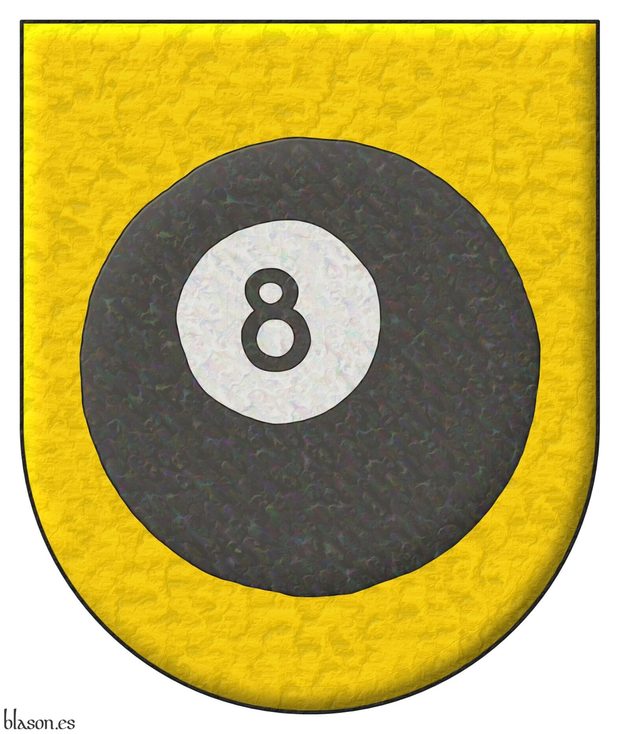
Imaginary coat of arms for the poolgame called Eight-ball.
Or, a Billiard 8 ball proper.
Coat of arms I created with: the shape semicircular at base; the field with a metallic finishing; and the charge with an iridescent finishing.
Blazon keywords: Without divisions, Or, One, Non-classic artifact and Proper.
Style keywords: Semi-circular, Crystalline, Soft metal, Outlined in sable and Illuminated.
Classification: Created, Imaginary and Coat of arms.
Imaginary bearer: Bola 8.


Eight-ball, heraldic poster
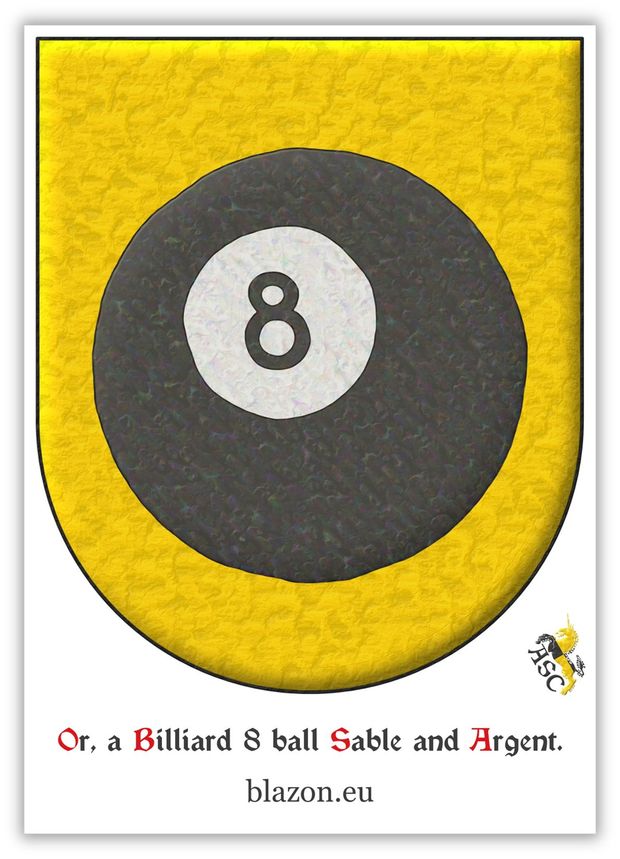
Or, a Billiard 8 ball proper.
Escudo de oro, una bola 8 de billar al natural.
Blazon keywords: Without divisions, Or, One, Non-classic artifact and Proper.
Style keywords: Semi-circular, Crystalline, Soft metal, Outlined in sable and Illuminated.
Classification: Created, Imaginary and Coat of arms.
Imaginary bearer: Bola 8.

Continue with: Eight-ball, another version with a terrace in base.
-
Language
-
Categories of heraldry
-
Divisions of the field
- Without divisions
- Party per pale
- Party per fess
- Party per bend
- Party per bend sinister
- Tierce
- Tierce sinister
- Tierced per pale
- Tierced per fess
- Tierced per bend
- Tierced pallwise inverted
- Quarterly
- Quarterly per saltire
- Gyronny
- Party per fess, the chief per pale
- Party per pale, the sinister per fess
- Party per fess, the base per pale
- Party per pale, the dexter per fess
- Chapé
- Chaussé
- Embrassé
- Contre-embrassé
- Party per chevron
- Enté
- Enté en point
- Flanched
-
Metals
-
Colours
-
Furs
-
Other tinctures
-
Ordinaries and sub-ordinaries
-
Diminutives of the ordinaries
-
Geometric charges
-
Composite ordinaries
-
Inanimate charges from Nature
Atom, Crescent, Diamond, Emerald, Estoile, Increscent, Lightning flash, Moon, Mount, Mullet, Mullet of four points, Orbital, Plough of Ursa Major, Rainbow, Ray of the sun, River, Sea, Snowflake, Sun, Sun in splendour, Sun of May, Trimount, Water and Wave.
-
Vegetal charges from Nature
Acorn, Apple, Apple tree, Ash, Bluebonnet, Camellia, Chrysanthemum, Cinquefoil, Cornflower, Dogwood flower, Double rose, Elm, Fleur de lis, Flower, Gourd, Holm oak, Hop cone, Indian paintbrush, Kapok tree, Laurel, Lily, Linden, Lotus flower, Madonna lily, Mexican cedar tree, Oak, Olive tree, Palm tree, Plantain plant, Pomegranate, Poplar leaf, Rose, Shamrock, Sunflower, Thistle, Tree, Tulip, Vine and Wheat.
-
Animal charges from Nature
Badger, Bald eagle, Barbel, Barn owl, Bear, Beaver, Bee, Beetle, Bighorn sheep, Binson, Blackbird, Boar, Brach hound, Bull, Doe, Dog, Dolphin, Dove, Eagle, Elephant, Falcon, Female figure, Fish, Flame, Fly, Fox, Frog, Goat, Goldfinch, Goose, Heron, Horse, Hummingbird, Jaguar, Lark, Leopard, Lion, Lion passant, Lion rampant guardant, Lioness, Lynx, Male figure, Martlet, Merino ram, Owl, Panther, Parrot, Peacock, Pelican, Pelican in her piety, Pronghorn, Puffin, Quetzal, Raven, Roe deer, Rooster, Savage, Seagull, Serpent, She-wolf, Stag, Starling, Talbot, Tyger, Vulture, Warren hound and Wolf.
-
Parts of natural charges
Arm, Beak, Branch, Caboshed, Chest, Claw, Covert, Dorsal fin, Eagle claw, Ermine spot, Escallop, Feather, Foot (palmiped), Foreleg, Forepaw, Hand, Head, Heart, Hoof, Leaf, Neck, Ostrich feather, Palm frond, Paw, Roe deers' attires, Shoulder, Sprig, Stags' attires, Stem, Swallow-tail, Tail, Tail addorsed, Tail fin, Talon, Tibia, Tooth, Trunk, Trunk (elephant), Two hands clasped, Two wings in vol, Udder, Wheat spike, Wing and Wrist.
-
Artificial charges
Ace of spades, Anchor, Anvil, Arch, Arm vambraced, Armillary sphere, Arrow, Axe, Bell, Bell tower, Beret, Bonfire, Book, Bookmark, Bow, Branding iron, Bridge, Broken, Buckle, Cannon, Cannon dismounted, Cannon port, Canopy roof, Carbuncle, Castle, Celtic Trinity knot, Chain, Chess rooks, Church, Clarion, Clay pot, Closed book, Club, Column, Comb, Compass rose, Conductor's baton, Cord, Covered cup, Crozier, Crucible, Cuffed, Cup, Cyclamor, Dagger, Double vajra, Drum, Ecclesiastical cap, Fanon, Federschwert, Fleam, Four crescents joined millsailwise, Galician granary, Garb, Gauntlet, Geometric solid, Grenade, Halberd, Hammer, Harp, Host, Hourglass, Key, Key ward, Knight, Knot, Lantern, Letter, Line, Loincloth, Menorah, Millrind, Millstone, Millwheel, Monstrance, Mortar, Mullet of six points pierced, Nail, Non-classic artifact, Norman ship, Number, Oar, Oil lamp, Open book, Page, Pair of scales, Parchment, Pestle, Piano, Pilgrim's staff, Plough share, Polish winged hussar, Port, Portcullis, Potent, Quill, Ribbon, Rosette of acanthus leaves, Sabre, Sackbut, Sail, Scroll, Scythe, Sheaf of tobacco, Ship, Skirt, Spear, Spear's head, Stairway, Star of David, Step, Sword, Symbol, Tetrahedron, Torch, Tower, Trident, Trumpet, Turret, Two-handed sword, Wagon-wheel, Water-bouget, Wheel, Winnowing fan and With a turret.
-
Immaterial charges
Angel, Archangel, Basilisk, Dragon, Dragon's head, Garuda, Golden fleece, Griffin, Heart enflamed, Justice, Mermaid, Our Lady of Mercy, Ouroboros, Paschal lamb, Pegasus, Phoenix, Sacred Heart of Jesus, Saint George, Sea-griffin, Trinity, Triton, Unicorn, Winged hand and Wyvern.
-
External elements
-
Heraldic creations
-
References
-
Formats
-
Keywords on this page
Port and windows, Proper, Armed, Ermine, Non-classic artifact, Azure, Bezant and plate, Bezant, Bibliography, Bola 8, Bordure, Wreath, Chain, Charged, Five, Decoration, Heart, Created, Crystalline, Quarterly, Outlined in sable, In saltire, Link, Coat of arms, Fernández-Cortés y Fonseca, Javier, Personal, Gules, Illuminated, Imaginary, Interpreted, Mantling, Langued, Lion, Semi-circular, Soft metal, Ordered, Or, Suspended, Argent, Without divisions, Base (lower 1/3), Rampant, Vert, Crest and mantling, Freehand, Three, Twelve Lineages of Soria, One and Helm.

